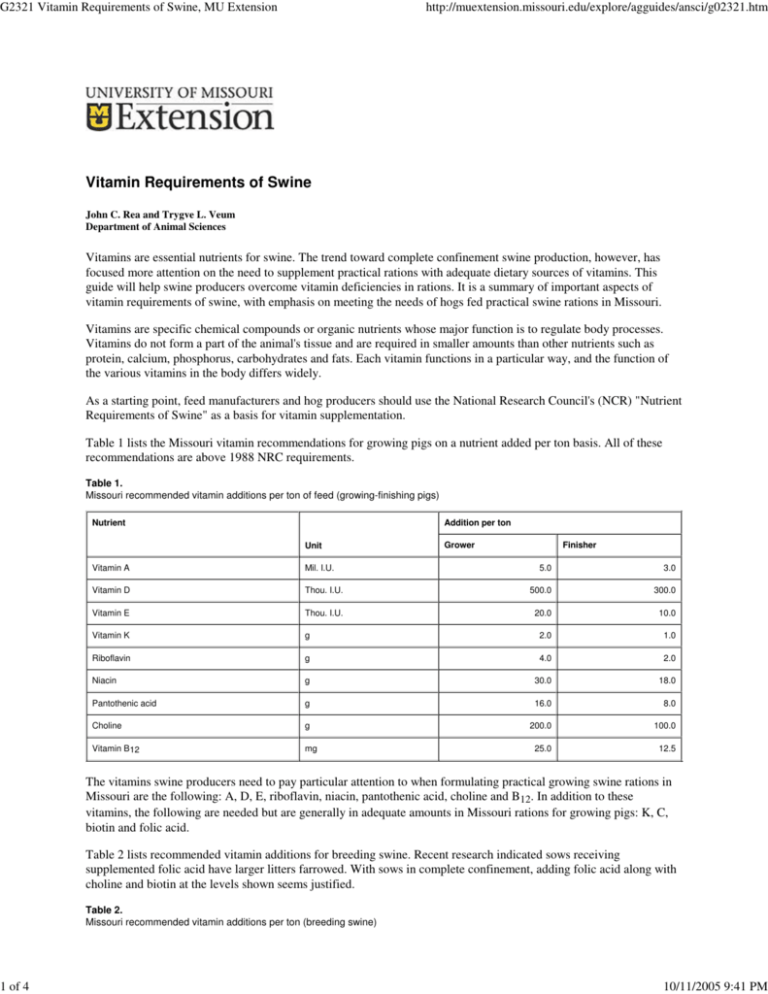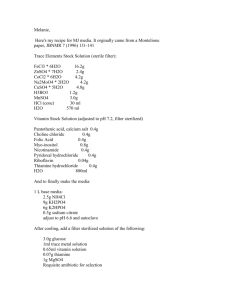
G2321 Vitamin Requirements of Swine, MU Extension
1 of 4
http://muextension.missouri.edu/explore/agguides/ansci/g02321.htm
Vitamin Requirements of Swine
John C. Rea and Trygve L. Veum
Department of Animal Sciences
Vitamins are essential nutrients for swine. The trend toward complete confinement swine production, however, has
focused more attention on the need to supplement practical rations with adequate dietary sources of vitamins. This
guide will help swine producers overcome vitamin deficiencies in rations. It is a summary of important aspects of
vitamin requirements of swine, with emphasis on meeting the needs of hogs fed practical swine rations in Missouri.
Vitamins are specific chemical compounds or organic nutrients whose major function is to regulate body processes.
Vitamins do not form a part of the animal's tissue and are required in smaller amounts than other nutrients such as
protein, calcium, phosphorus, carbohydrates and fats. Each vitamin functions in a particular way, and the function of
the various vitamins in the body differs widely.
As a starting point, feed manufacturers and hog producers should use the National Research Council's (NCR) "Nutrient
Requirements of Swine" as a basis for vitamin supplementation.
Table 1 lists the Missouri vitamin recommendations for growing pigs on a nutrient added per ton basis. All of these
recommendations are above 1988 NRC requirements.
Table 1.
Missouri recommended vitamin additions per ton of feed (growing-finishing pigs)
Nutrient
Addition per ton
Unit
Vitamin A
Mil. I.U.
Vitamin D
Grower
Finisher
5.0
3.0
Thou. I.U.
500.0
300.0
Vitamin E
Thou. I.U.
20.0
10.0
Vitamin K
g
2.0
1.0
Riboflavin
g
4.0
2.0
Niacin
g
30.0
18.0
Pantothenic acid
g
16.0
8.0
Choline
g
200.0
100.0
Vitamin B12
mg
25.0
12.5
The vitamins swine producers need to pay particular attention to when formulating practical growing swine rations in
Missouri are the following: A, D, E, riboflavin, niacin, pantothenic acid, choline and B12. In addition to these
vitamins, the following are needed but are generally in adequate amounts in Missouri rations for growing pigs: K, C,
biotin and folic acid.
Table 2 lists recommended vitamin additions for breeding swine. Recent research indicated sows receiving
supplemented folic acid have larger litters farrowed. With sows in complete confinement, adding folic acid along with
choline and biotin at the levels shown seems justified.
Table 2.
Missouri recommended vitamin additions per ton (breeding swine)
10/11/2005 9:41 PM
G2321 Vitamin Requirements of Swine, MU Extension
2 of 4
http://muextension.missouri.edu/explore/agguides/ansci/g02321.htm
Nutrient
Unit
Addition per ton
Vitamin A
Mil. I.U.
5.0
Vitamin D
Thou. I.U.
500
Vitamin E
Thou. I.U.
25
Vitamin K
g
2.0
Riboflavin
g
5.0
Niacin
g
30.0
Pantothenic acid
g
18.0
Vitamin B12
mg
25.0
Choline Chloride
g
700
Folic acid
mg
300
Biotin
mg
200
Vitamin sources and general comments
Vitamin needs of swine are met either from that contained in the feed or from synthesis in the body of the animal.
Determinations have been made of the vitamin content of many swine feeds. These are average figures and, in some
cases, are influenced drastically by the method of harvesting, processing and storing.
Vitamin A
Vitamin A functions in the growth of both skeletal and soft tissues of the body: in vision, reproduction and disease
resistance. Vitamin A does not occur in plant products but the plant pigment carotene can be converted to vitamin A in
the intestinal wall of the pig. Yellow corn is the only cereal grain that contains significant amounts of carotene.
Forages are good sources of carotene, but they are seldom used in today's practical rations. One milligram of
B-carotene is equivalent to 500 I.U. of biologically active vitamin A for the pig.
Good sources of carotene or vitamin A are found in yellow corn (although 60 percent may be destroyed in several
months of storage by light, high temperature, air, etc.), green forages, sun-cured legumes, dehydrated alfalfa meal,
cod-liver oil and fish oils. Both carotene and vitamin A are readily destroyed by the following:
Storage and exposure to air.
Exposure to light and high temperature.
Exposure to metals such as iron hasten destruction.
Exposure to rancid fats.
Grinding, which helps destroy the carotene in corn.
For these reasons on a practical basis, we should assume that pigs in dry lot receive very little, if any, vitamin A in
their diets.
Weak, malformed, blind and eyeless pigs may be farrowed by sows deficient in vitamin A.
Vitamin D
Vitamin D functions in the pig's body to increase the absorption of calcium and phosphorus from the intestines. It is
necessary for good bone growth and calcification. Vitamin D2 sources include sun-cured hays, irradiated yeast and
dehydrated alfalfa meal. Sources of D3 include fish-oils and fish meals and formation of D3 in the skin by sunshine.
Swine exposed to sunshine in the summer should not need dietary vitamin D. During the winter months and in
confinement rearing, it is important that rations be supplemented with vitamin D.
Vitamin E
Vitamin E is required for normal reproduction and growth. Common swine feeds are good sources — green pastures,
cured hay, alfalfa meal, whole grains and germ parts of grain. In Missouri, vitamin E deficiencies are not common, but
as a safeguard, it can be added cheaply in a premix.
Deficiency symptoms have been diagnosed in some of the northern midwest states. Michigan State University has
reported several vitamin E — selenium deficiencies in swine herds. In areas where selenium levels are low, reports of
vitamin E shortages have been more common.
10/11/2005 9:41 PM
G2321 Vitamin Requirements of Swine, MU Extension
3 of 4
http://muextension.missouri.edu/explore/agguides/ansci/g02321.htm
There is a definite relationship between vitamin E and the trace mineral selenium. Adding recommended selenium
levels reduces the need for vitamin E. Apparently selenium is needed for good use of vitamin E. Loss of vitamin E in
normal feeds due to handling and storage, less use of pasture and alfalfa meal, and extensive use of some drugs are
believed to contribute to the vitamin E deficiencies in some herds.
Trace mineral selenium can be added legally to rations at a level of 0.3 part per million. This should reduce problems
from marginal vitamin E levels.
Vitamin K
Under ordinary circumstances vitamin K is supplied in adequate amounts in normal swine diets and the microbial
synthesis in the intestines. The major function of vitamin K is its blood clotting role.
From time to time, cases are reported that seem to indicate a shortage of vitamin K in swine rations. The presence of
mold in feed has been found to interfere with normal use of vitamin K by pigs. In Nebraska studies of moldy feed, the
addition of 2 grams of menadione sodium bisulfite per ton corrected vitamin K deficiency symptoms in affected pigs.
Check moisture levels at the time grains are stored and again in the spring and process to reduce mold risk.
With normal feeds vitamin K should be adequate in Missouri swine rations, but it may be included where mold is
present or past experience indicates a need for additional vitamin K.
Water-soluble vitamins
Vitamins generally are classified according to solubility. The four vitamins discussed (A, D, E and K) are fat-soluble,
and the remaining mentioned are water-soluble. Of the latter group, biotin, vitamin C and folic acid generally are not
of practical concern in growing swine rations because adequate amounts appear to be synthesized by the animal.
Thiamine and vitamin B6 are supplied in more than adequate amounts by the feed in normal swine rations. Recent
research shows an increase in pigs per litter from adding folic acid to sow rations.
Riboflavin functions in the animal's enzyme system. It is heat-stable but is destroyed by alkali and light. It is
available in good amounts in legume hays, dairy byproducts and in fair amounts in tankage and soybean oil
meal. Cereal grains are a rather poor source of riboflavin.
Niacin functions as a co-enzyme. It is resistant to heat and is quite stable in feeds. Fish meals, corn distillers
solubles and wheat bran are good sources of niacin. It may be in a bound or unavailable form in cereal grains,
especially corn.
Pantothenic acid is stable in heat and light. Common feed sources are milk products, alfalfa meal, wheat bran
and fish solubles. Practical diets tend to be borderline in pantothenic acid. Corn is a poor source.
"Goose-stepping" is a common symptom of pantothenic acid deficiency.
Choline is required for small pigs. It can be synthesized from methionine. This increases the methionine
requirements in choline deficient diets. Sources are meat and bone meal, soybean oil meal, fish meal and
grains. Practical swine grower rations should contain adequate levels of choline, particularly for heavyweight
hogs. Research has shown that feeding pregnant sows supplemental choline generally increases numbers of
pigs born and, in some experiments, pigs weaned.
Vitamin B12 is required for growth, hemoglobin and red blood cell formation. It is available in animal
byproducts and commercial preparations. Plant products are deficient, and where rations are formulated based
primarily on corn and soybean-oil meal, supplemental sources need to be supplied.
Folic acid is an essential B-vitamin for swine. Green leafy plants are an excellent source. Bacteria in the pigs'
lower gut also can synthesize folic acid, making feces a source of this vitamin. Confinement practices of raising
hogs has reduced both of these vitamin sources so research now indicates supplemental sources of folic acid
should be added to the feed. Recent research has shown a mild increase in pigs born when folic acid is added to
sow rations.
Vitamin deficiency symptoms
Table 3 lists clinical and sub-clinical symptoms of vitamin deficiencies. Some of these are more specific than others.
Some deficiencies don't occur on practical swine rations. However, studies have been made using semi-purified rations
that are lacking in specific vitamins, and deficiency symptoms have been determined.
Table 3.
Symptoms of vitamin deficiency in swine
Vitamin
Clinical symptoms1
Sub-clinical symptoms2
10/11/2005 9:41 PM
G2321 Vitamin Requirements of Swine, MU Extension
4 of 4
http://muextension.missouri.edu/explore/agguides/ansci/g02321.htm
Vitamin A
Poor growth, unsteady gait, birth of abnormal pigs,
hyperkeratinization of skin, xerophthalmia
Low liver vitamin A, elevated cerebrospinal fluid pressure,
low plasma vitamin A
Vitamin D
Poor growth, leg weakness
Rickets, low plasma Ca and P, elevated plasma alkaline
phosphatase
Vitamin E
Sudden death, paleness
Liver necrosis, mulberry heart, pale musculature, edema,
jaundice
Vitamin K
Sudden death
Internal hemorrhages, slow blood clotting time
Thiamine
Poor growth, loss of appetite, sudden death
Enlarged flabby heart, abnormal electrocardiogram, elevated
blood pyruvate
Riboflavin
Poor growth, red exudate around eyes, birth of dead or weak pigs
Lens cataracts, increase of blood neutrophils
Niacin
Poor growth, necrotic enteritis
Normocytic anemia
Pantothenic
acid
Poor growth, goose stepping, posterior paralysis, birth of small, weak
pigs
Sciatic nerve degeneration
Vitamin B6
Poor growth, epileptic convulsions
Low blood hemoglobin, high plasma iron, high urinary
xanthurenic acid
Vitamin B12
Poor growth, irritable, birth of weak pigs
Low serum B12, low lymphocyte count, enlarged liver
Choline
Birth of pigs with spraddle legs
Fatty liver, kidney necrosis
Folic acid
Poor growth
Normocytic anemia
Biotin
Dermatitis, cracked hoof
1Observations made on the animal
2Determined from tests of postmortem examination
Meeting vitamin needs in practical swine rations
Producers buying complete mixed feeds or commercial supplements to feed with home-grown grains generally must
rely on their company to provide adequate amounts of vitamins. Those formulating and mixing complete rations need
to pay particular attention to meeting vitamin needs. (See MU publication G2351, Evaluating Vitamin Premixes for
Swine.) Missouri recommendations are that vitamins that are short of borderline in feeds should be provided in a
commercial vitamin pre-mix at levels shown in Tables 1 and 2.
Vitamin pre-mixes don't add much to the total cost per ton of feed, and there is less chance for error providing these
vitamins in this form rather than relying on average amounts of feed, particularly with variations in processing and
storing and changes in management of hogs.
Web maintenance 7/22/05
University of Missouri Extension
© 1993 to 2005 Curators of the University of Missouri, all rights reserved
10/11/2005 9:41 PM







